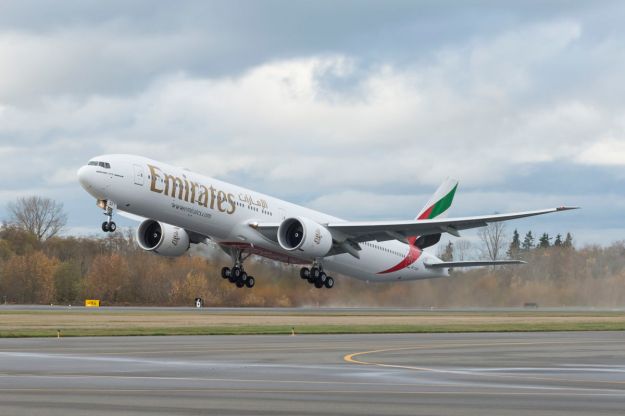Boeing 777er
Seat Map of Boeing 777-300ER (77W) On this page, you will find seat map information on the Boeing 777-300ER (77W) aircraft. For further details on seats, please go to the in-flight service page and select the class and aircraft type. Everett, Washington (CNN) — The world's longest and largest twin-engine airliner, the Boeing 777-9X, has finally taken to the skies for its maiden flight, offering a ray of hope for the troubled US. The Boeing 777X is the latest series of the long-range, wide-body, twin-engine Boeing 777 family from Boeing Commercial Airplanes.The 777X features new GE9X engines, new composite wings with folding wingtips, greater cabin width and seating capacity, and technologies from the Boeing 787.The 777X was launched in November 2013 with two variants: the 777-8 and the 777-9. Boeing 777 A Boeing 777 operated by Cathay Pacific in 2011. The 777 is a low-wing twinjet; the original -200 is the shortest variant. Role Wide-body airliner National origin United States Manufacturer Boeing Commercial Airplanes First flight June 12, 1994 Introduction June 7, 1995 with United Airlines Status In production Primary users Emirates United Airlines Air France Cathay Pacific. GE Capital Aviation Services (GECAS) has delivered a Boeing 777-300/ER to Israel Aerospace Industries (IAI) for freighter conversion, to become the prototype B777-300ERSF. The aircraft to be converted is owned by GE, and was previously leased to Emirates, registered A6-EBB.
| Boeing 777 | |
|---|---|
| Japan Airlines Boeing 777-300 about to land at London Heathrow Airport | |
| Role | |
| National origin | United States |
| Manufacturer | Boeing Commercial Airplanes |
| First flight | June 12, 1994 |
| Introduction | June 7, 1995 with United Airlines[1] |
| Status | Being made and being used by airlines |
| Primary users | Emirates United Airlines Cathay Pacific Air France |
| Produced | 1994–present |
| Number built | 1,538[2] |
| Unit cost | 777-200ER: US$ 261.5 million 777-200LR: US$296.0 million 777-300ER: US$320.2 million 777F: US$300.5 million[3] |
The Boeing 777 is a long range, twin-engine, widebody commercial airliner. It is the world's largest twinjet plane. It is often called the 'Triple Seven'. It can carry between 283 and 368 passengers. It has a range from 5235 to 9380 nautical miles.
The first 777-200 model first entered service in 1995. The stretched 777-300 was introduced in 1998. That model is 33.3 feet (10.1 meters) longer. The longer-range 777-300ER and 777-200LR models entered service in 2004 and 2006, respectively. A freighter version, the 777F, first flew in 2008. Beginning in 2019, Boeing will deliver a new version of the 777, the 777X.
More than 60 airlines operate one or more kinds of the Boeing 777. Of them, Emirates has the most in its fleet: more than 100 of them are in service or on order. Other airlines that operate a lot of 777s include United Airlines, Air France, Cathay Pacific, and American Airlines.
Variants[change change source]
Variants include:
-200s variants
- 777-200 (772)
- 777-200ER (772)
- 777-200LR 'Worldliner' (77L)
-300s variants
- 777-300 (773)
- 777-300ER (77W)
Freight variants

- 777F
In-development variants (777X)
- 777-8 (778)
- 777-9 (779)
777-200[change change source]
The 777-200 was the first and original type of 777. It was first flown on June 12, 1994 and entered service with United Airlines on June 7, 1995. It was made to fly up to 440 people in a single class layout, and could fly 5240 nautical miles (9700 km).[4] 88 777-200 were made, with no -200 waiting to be made.
777-200ER[change change source]
The 777-200ER ('ER' for Extended Range) is an extended range version and the B-market model of the original 777-200. This means it could fly longer than the original version. Although the number of passengers able to be carried remains the same, the range of the -200ER is increased to 7725 nautical miles (14,305 km). 422 -200ER were made, with no -200ER waiting to be made.
777-200LR[change change source]
The 777-200LR ('LR' for Longer Range) is a longer-range version and the C-market model of the 777-200. The 777-200LR holds the record for longest-ever flight, totaling 22 hours, 42 minutes and flew 11,664 nautical miles from Hong Kong to London. It has a capacity of 301 passengers. [5]

777-300[change change source]
Boeing 777 Er
The 777-300 was launched at the Paris Air Show on June 26, 1995, its major assembly started in March 1997 and its body was joined on July 21, it was rolled-out on September 8 and made its first flight on October 16 and it entered service with Cathay Pacific on June 27, 1998. The 777-300 was designed as a stretch of its fuselage by 20% from the 200's version and have extra seats.
Boeing 777er Seating
777-300ER[change change source]
The 777-300ER is the B-market version of the 777-300. This means the 777-300ER have a higher maximum takeoff weight (MTOW) and can fly with a maximum range up to 7,370 nautical miles (13,650 km) with 396 passengers in a two-class seating arrangement. The 777-300ER features raked and extended wingtips, a strengthened fuselage and wings and a modified main landing gear. Its wings have an aspect ratio of 9.0. It is powered by the GE90-115B turbofan, the world's most powerful jet engine with a maximum thrust of 115,300 lbf (513 kN).
777-8 and -9[change change source]

Launched in November 2013, the under development 777X will feature GE9X new engines, new carbon fiber wings with folding wingtips and a denser cabin. The longer 777-9, seating 414 over 7,600 nmi (14,075 km), should fly in the first quarter of 2019 and be delivered from December 2019, while the shorter 777-8 would seat 365 over 8,700 nmi (16,110 km).
Gallery[change change source]
Cockpit of an American Airlines 777
The first Boeing 777-200 to ever fly people
A Malaysia Airlines 777-200ER 'Super Ranger', named for its very long range
Boeing 777-300/-200 of Japan Airlines
A 777 engine
References[change change source]
- ↑'Boeing: The Boeing 777 Program Background.' Boeing. retrieved February 20, 2014.
- ↑'777 Model Orders and Deliveries summaryArchived 2013-08-23 at WebCite'. Boeing. January 2014. Retrieved February 20, 2014.
- ↑'Boeing: Jet prices.' Retrieved February 20, 2014.
- ↑'Boeing: 777-200/-200ER Technical Characteristics.' Boeing. Retrieved February 20, 2014.
- ↑'News Releases/Statements'. MediaRoom. Retrieved 2018-02-15.
Other websites[change change source]
Media related to Boeing 777 at Wikimedia Commons
| Boeing 7x7 aircraft timeline, 1955–now | ||||||||||||||||||||||||||||||||||||||||||||||||||||||||||
|---|---|---|---|---|---|---|---|---|---|---|---|---|---|---|---|---|---|---|---|---|---|---|---|---|---|---|---|---|---|---|---|---|---|---|---|---|---|---|---|---|---|---|---|---|---|---|---|---|---|---|---|---|---|---|---|---|---|---|
| 1950s | 1960s | 1970s | 1980s | 1990s | 2000s | 2010s | ||||||||||||||||||||||||||||||||||||||||||||||||||||
| 1955 | 1956 | 1957 | 1958 | 1959 | 1960 | 1961 | 1962 | 1963 | 1964 | 1965 | 1966 | 1967 | 1968 | 1969 | 1970 | 1971 | 1972 | 1973 | 1974 | 1975 | 1976 | 1977 | 1978 | 1979 | 1980 | 1981 | 1982 | 1983 | 1984 | 1985 | 1986 | 1987 | 1988 | 1989 | 1990 | 1991 | 1992 | 1993 | 1994 | 1995 | 1996 | 1997 | 1998 | 1999 | 2000 | 2001 | 2002 | 2003 | 2004 | 2005 | 2006 | 2007 | 2008 | 2009 | 2010 | 2011 | 2012 | 2013 |
| Boeing 707 | ||||||||||||||||||||||||||||||||||||||||||||||||||||||||||
| Boeing 717 (MD-95) | ||||||||||||||||||||||||||||||||||||||||||||||||||||||||||
| Boeing 727 | ||||||||||||||||||||||||||||||||||||||||||||||||||||||||||
| Boeing 737 | ||||||||||||||||||||||||||||||||||||||||||||||||||||||||||
| Boeing 747 | ||||||||||||||||||||||||||||||||||||||||||||||||||||||||||
| Boeing 757 | ||||||||||||||||||||||||||||||||||||||||||||||||||||||||||
| Boeing 767 | ||||||||||||||||||||||||||||||||||||||||||||||||||||||||||
| Boeing 777 | ||||||||||||||||||||||||||||||||||||||||||||||||||||||||||
| Boeing 787 | ||||||||||||||||||||||||||||||||||||||||||||||||||||||||||
| = Not being made anymore | = Still being made | |||||||||||||||||||||||||||||||||||||||||||||||||||||||||

Boeing has revised its development schedule for the 777X to reflect a late 2023 first delivery and resumption of shipments of the 787 Dreamliner late in the first quarter as the company’s widebody programs continue to address technical snags and market softness. Speaking Wednesday during the company’s fourth-quarter 2020 earnings call, Boeing CEO David Calhoun explained that the 777X delay centers on three main factors, leading with an updated assessment of global certification requirements influenced by the 737 Max grounding.
“We’re working closely with global regulators on all aspects of 777X development,” said Calhoun. “This involves listening to all their feedback and applying lessons learned from our experiences on the 737 Max program recertification and applying it to our 777 certification plans. It also involves making prudent design modifications as necessary to meet the various global regulators' expectations.”
As part of its assessment, Boeing decided to make “certain modifications” to the aircraft design involving both software and hardware changes to the actuator control electronics, he explained, reflecting the company’s “current judgment of global regulators compliance expectations.”
Calhoun also named downward long-term expectations for passenger traffic brought about by the Covid pandemic on long-haul routes, in particular, shifting 'to the right' the anticipated replacement wave of widebodies in the capacity range of the 777X. Finally, the 777X’s customers have asked for delivery deferrals directly due to their projections for their own fleet needs over the coming few years.
“These broader market factors, coupled with our conversations with our customers about preferred delivery timing, informed our current assumptions,” noted Calhoun. As a result, Boeing took a $6.5 billion accounting charge during the fourth quarter and changed its program assumptions to reflect a 50-unit reduction in program accounting quantity, from 400 to 350 airplanes. Still, Boeing projects a market for 1,500 large widebodies in the category of the 777X over the next 20 years.
Separately, continuing inspections and rework of body join on 80 Dreamliners in inventory has forced the company to delay the re-start of deliveries of that widebody from the end of last year to “late in the first quarter” of this year, reported Calhoun. Last September Boeing found that mechanics clamped together certain components in the horizontal stabilizer with greater force than required by engineering specifications. The mistake could result in improper gap verification or shimming as workers assemble the component. That issue further slowed deliveries as the company performed special inspections to address imperfections in fuselage skins and shimming problems within some of the airplanes’ aft fuselages first discovered in 2019. On Wednesday, Calhoun didn’t identify the exact location of the body join problems that led to a halt in deliveries in the fourth quarter, noting only that they didn’t present a safety-of-flight issue.
“Since last quarter, we've expanded the scope of those inspections, including work done at our supplier partners,” he said. “Our assessment shows that none of the issues identified represent safety-of-flight concerns.'
“We've been able to determine the resolution for the majority of previously identified areas, including our major join sections,' added Calhoun. 'In some cases, this requires inspections and rework while in other areas, no further action is required. We've made good progress and are now completing an analysis on a few remaining areas to validate the next steps. As we see it today, this work may take a few more weeks, but we will provide our engineers the time they need to complete that analysis. We are implementing changes in the production process to ensure newly built airplanes, meet our specifications and do not require further inspection.”
United Boeing 777 200 Hawaii
Calhoun further confirmed that Boeing would not deliver any 787s this month and just a few, if any, in February. Boeing plans to reduce production to five airplanes a month in March, when it fully consolidates final assembly to its plant in Charleston, South Carolina.